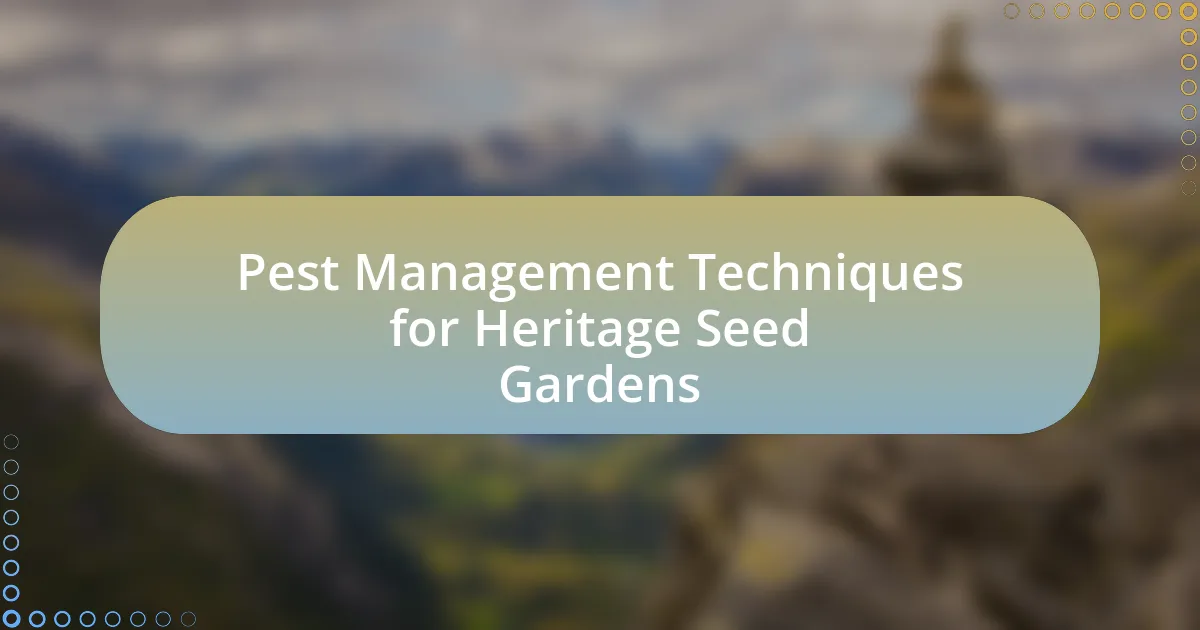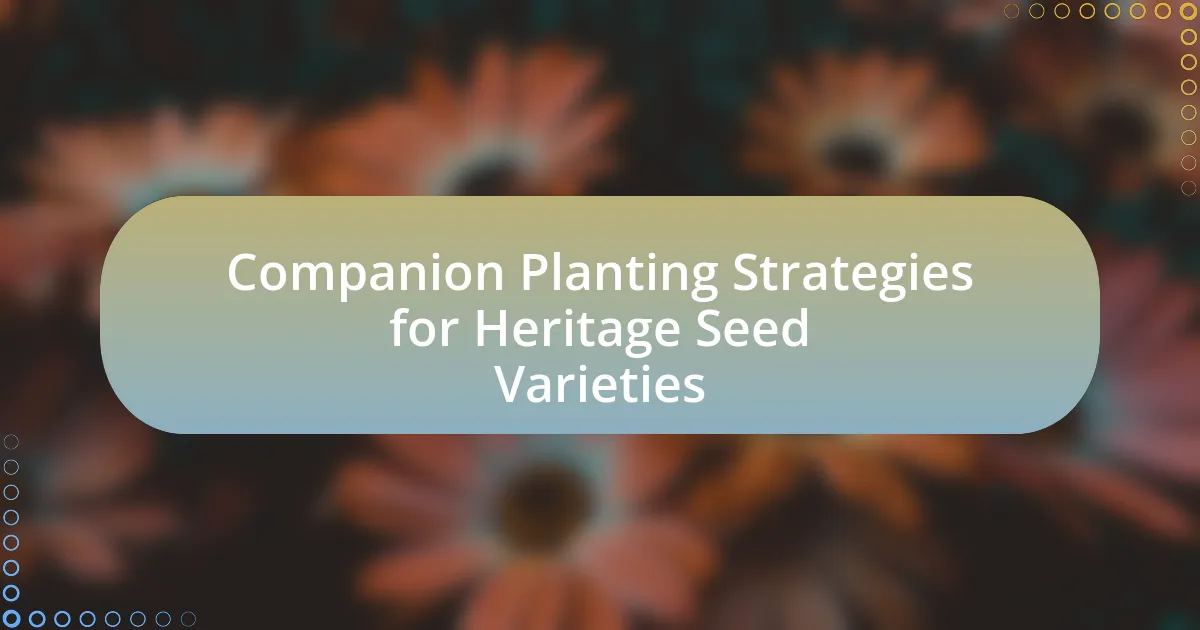Creating a biodiverse garden with heritage seed varieties focuses on cultivating ecological diversity through traditional, non-hybrid seeds that enhance genetic diversity and support local ecosystems. This practice improves soil health, attracts beneficial insects, and increases resilience against pests and diseases, contributing to sustainable gardening. The article explores the importance of biodiversity in gardening, the role of heritage seeds in preserving genetic diversity, and practical steps for establishing and maintaining a biodiverse garden. It also addresses challenges such as pest management and soil health, while providing tips for successful gardening with heritage varieties.

What is Creating a Biodiverse Garden with Heritage Seed Varieties?
Creating a biodiverse garden with heritage seed varieties involves cultivating a garden that prioritizes ecological diversity by using traditional, non-hybrid seeds that have been passed down through generations. This practice enhances genetic diversity, supports local ecosystems, and preserves unique plant traits that are often lost in modern agriculture. Research indicates that gardens with diverse plant species can improve soil health, attract beneficial insects, and increase resilience against pests and diseases, thereby contributing to sustainable gardening practices.
Why is biodiversity important in gardening?
Biodiversity is important in gardening because it enhances ecosystem resilience, promotes soil health, and supports a variety of plant and animal species. A diverse garden can better withstand pests and diseases, as different species can provide natural pest control and reduce the likelihood of widespread crop failure. Additionally, diverse plant life contributes to improved soil structure and fertility through varied root systems and organic matter contributions. Studies have shown that gardens with higher biodiversity can yield more produce and require fewer chemical inputs, making them more sustainable and environmentally friendly.
How does biodiversity contribute to ecosystem health?
Biodiversity significantly contributes to ecosystem health by enhancing resilience, stability, and productivity. Diverse species fulfill various ecological roles, such as pollination, nutrient cycling, and pest control, which are essential for maintaining ecosystem functions. For instance, a study published in the journal “Nature” found that ecosystems with higher species diversity are better able to withstand environmental stressors, such as climate change and disease outbreaks, due to the presence of multiple species that can adapt to changing conditions. This interdependence among species fosters a balanced ecosystem, ultimately leading to improved soil health, water quality, and overall ecological integrity.
What role do heritage seed varieties play in biodiversity?
Heritage seed varieties play a crucial role in biodiversity by preserving genetic diversity within plant species. These seeds, often heirloom varieties, maintain unique traits that have adapted to specific local environments over generations. This genetic diversity is essential for ecosystem resilience, enabling plants to withstand diseases, pests, and changing climate conditions. Studies indicate that maintaining a wide range of seed varieties can enhance agricultural sustainability and food security, as diverse crops can better adapt to environmental stresses. For example, the Seed Savers Exchange has documented over 25,000 varieties of heritage seeds, showcasing their importance in maintaining biodiversity and promoting ecological balance.
What are heritage seed varieties?
Heritage seed varieties are traditional plant seeds that have been passed down through generations, often cultivated for their unique characteristics and adaptability to local environments. These seeds are typically open-pollinated, meaning they can reproduce naturally and maintain their genetic traits over time. Heritage seeds are valued for their biodiversity, flavor, and resilience, contributing to sustainable agriculture and preserving genetic diversity in crops. According to the Seed Savers Exchange, heritage seeds are often defined as those that have been in cultivation for at least 50 years, ensuring a rich history and connection to cultural practices.
How do heritage seeds differ from hybrid and GMO seeds?
Heritage seeds are distinct from hybrid and GMO seeds primarily in their genetic makeup and breeding methods. Heritage seeds are open-pollinated varieties that have been passed down through generations, maintaining their genetic integrity and traits over time, which allows them to be replanted and produce seeds that are true to type. In contrast, hybrid seeds are created through controlled cross-pollination of different plant varieties, resulting in offspring that may exhibit desirable traits but do not produce seeds that reliably replicate those traits in subsequent generations. GMO seeds, or genetically modified organisms, involve direct manipulation of an organism’s DNA in a laboratory setting to introduce specific traits, such as pest resistance or herbicide tolerance, which can lead to unintended ecological consequences. The preservation of genetic diversity in heritage seeds supports sustainable agriculture and biodiversity, while hybrids and GMOs often prioritize uniformity and specific traits for commercial agriculture.
What are the benefits of using heritage seed varieties in a garden?
Using heritage seed varieties in a garden enhances biodiversity, promotes sustainability, and preserves genetic diversity. Heritage seeds are often more resilient to local pests and diseases due to their long history of adaptation, which can lead to healthier plants and better yields. Additionally, these varieties typically have superior flavor and nutritional value compared to many commercial hybrids. Research indicates that heritage seeds contribute to ecological balance by supporting a wider range of pollinators and beneficial insects, thus fostering a more vibrant garden ecosystem.
How can one start creating a biodiverse garden?
To start creating a biodiverse garden, one should select a variety of native plants, vegetables, and flowers that attract different species of wildlife. This approach enhances ecosystem resilience and promotes a balanced environment. Research indicates that gardens with diverse plant species support a wider range of pollinators and beneficial insects, which are crucial for plant health and productivity. For instance, a study published in the journal “Ecological Applications” found that gardens with at least 20 different plant species significantly increased the abundance of pollinators compared to monoculture gardens. Therefore, incorporating a mix of heritage seed varieties can further enrich biodiversity, as these seeds often support local ecosystems and provide food sources for various organisms.
What steps should be taken to assess the garden space?
To assess the garden space, begin by evaluating the sunlight exposure, as different plants require varying amounts of light. Measure the area to determine its size and shape, which influences plant selection and layout. Next, analyze the soil quality by testing its pH and nutrient levels, as healthy soil is crucial for plant growth. Additionally, observe the existing flora and fauna to understand the local ecosystem, which can inform biodiversity efforts. Finally, consider the garden’s proximity to water sources and accessibility for maintenance, ensuring that the design supports sustainable gardening practices.
How can one select appropriate heritage seed varieties for their garden?
To select appropriate heritage seed varieties for a garden, one should assess the local climate, soil conditions, and intended use of the plants. Understanding the specific growing conditions in your area, such as temperature ranges and soil type, helps in choosing varieties that thrive in those environments. For instance, certain heritage tomatoes are well-suited for warmer climates, while others may perform better in cooler regions. Additionally, selecting seeds based on the desired culinary or ornamental use ensures that the plants meet the gardener’s needs. Researching local agricultural extension services or seed catalogs can provide valuable insights into which heritage varieties are best adapted to specific regions, enhancing the likelihood of a successful and diverse garden.
What challenges might arise when creating a biodiverse garden?
Creating a biodiverse garden can present several challenges, including selecting appropriate plant species, managing pests and diseases, and ensuring proper soil health. The selection of plant species is critical, as not all plants will thrive in the same environment, and some may outcompete others, reducing overall biodiversity. Managing pests and diseases can be complex, as a diverse ecosystem may attract various pests, necessitating careful monitoring and potentially organic pest control methods. Additionally, maintaining soil health is essential for supporting a variety of plants; poor soil conditions can hinder growth and reduce biodiversity. These challenges require careful planning and ongoing management to successfully establish and maintain a biodiverse garden.
How can pests and diseases affect heritage seed varieties?
Pests and diseases can significantly reduce the viability and yield of heritage seed varieties. These traditional seeds often lack the genetic diversity found in modern hybrids, making them more susceptible to specific pests and diseases. For instance, a study published in the journal “Agricultural Systems” found that heritage varieties of tomatoes were more vulnerable to late blight, a fungal disease, compared to hybrid varieties, leading to substantial crop losses. Additionally, pests like aphids can transmit viruses that specifically target heritage crops, further diminishing their productivity. This vulnerability underscores the importance of integrated pest management and disease-resistant breeding strategies to protect these valuable genetic resources.
What are common mistakes to avoid when planting heritage seeds?
Common mistakes to avoid when planting heritage seeds include neglecting soil preparation, failing to understand the specific growing conditions required for each variety, and not allowing for proper spacing between plants. Soil preparation is crucial because heritage seeds often thrive in nutrient-rich, well-drained soil; inadequate soil can hinder growth and yield. Understanding the specific needs of each variety, such as sunlight, water, and temperature, is essential, as different heritage seeds may have unique requirements that, if unmet, can lead to poor germination or stunted growth. Additionally, proper spacing is important to ensure adequate air circulation and reduce competition for nutrients, which can affect plant health and productivity.
How can one maintain a biodiverse garden over time?
To maintain a biodiverse garden over time, one should implement practices such as crop rotation, companion planting, and the use of native plants. Crop rotation prevents soil depletion and reduces pest buildup, while companion planting enhances plant health and biodiversity by promoting beneficial interactions among species. Utilizing native plants supports local ecosystems and attracts pollinators, which are crucial for plant reproduction. Research indicates that gardens with diverse plant species can increase resilience against pests and diseases, as demonstrated in studies by the University of California, which found that biodiversity can enhance ecosystem services and overall garden productivity.
What practices promote the health of heritage seed varieties?
Practices that promote the health of heritage seed varieties include crop rotation, organic pest management, and maintaining genetic diversity. Crop rotation helps prevent soil depletion and reduces pest and disease buildup, which is crucial for the vitality of heritage seeds. Organic pest management utilizes natural predators and organic treatments to protect plants without harming beneficial organisms, thereby supporting the ecosystem around heritage varieties. Additionally, maintaining genetic diversity through seed saving and exchanging ensures resilience against diseases and environmental changes, as diverse genetic traits can enhance adaptability. These practices collectively contribute to the sustainability and robustness of heritage seed varieties in biodiverse gardens.
How can seasonal changes impact garden biodiversity?
Seasonal changes significantly impact garden biodiversity by influencing plant growth cycles, pollinator activity, and soil health. For instance, varying temperatures and precipitation patterns during different seasons can affect the availability of resources for both flora and fauna. In spring, warmer temperatures and increased rainfall promote the growth of diverse plant species, which in turn attract a variety of pollinators such as bees and butterflies. Conversely, during winter, many plants enter dormancy, reducing food sources for wildlife and limiting biodiversity. Research indicates that gardens with a variety of heritage seed varieties can better withstand seasonal fluctuations, as these plants are often more resilient and adapted to local conditions, thereby supporting a wider range of species throughout the year.
What are some practical tips for success in creating a biodiverse garden with heritage seed varieties?
To successfully create a biodiverse garden with heritage seed varieties, start by selecting a diverse range of heritage seeds that are well-suited to your local climate and soil conditions. Incorporating a variety of plants, including flowers, vegetables, and herbs, enhances ecosystem resilience and attracts beneficial insects. Additionally, practice crop rotation and companion planting to improve soil health and reduce pests naturally.
Research indicates that gardens with higher plant diversity can support a wider range of wildlife, which contributes to pollination and pest control. For example, a study published in the journal “Ecological Applications” found that diverse plant communities can increase the abundance of pollinators by up to 50%. Furthermore, maintaining organic practices, such as avoiding synthetic fertilizers and pesticides, fosters a healthier garden environment that supports heritage varieties.





